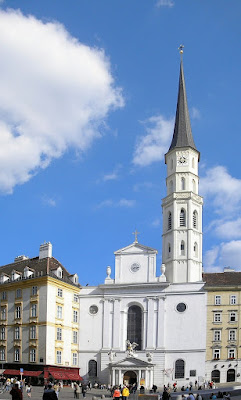To the Gaffers
I wanted people to let me
In peace´ and unscathed,
I'm only certainly
A human born like them.
Bile's almost coming out of me,
When they fix me up like that?
I'd like to creep into a snail shell.
And die of anger.
If I see an opera glass
Treacherously directed at me,
I wanted this this,
And the person is destroyed.
Poetry of The Empress Sisi (Elizabeth of Austria). More about her later, but Princess Diana and Megan Markle might be clones.
The Viking Cruise line has many advantages for travelers, but like so many boat trips, doesn't give you much time in any one place. And seeing Vienna even superficially in a day is impossible, so we decided to go back for a second look after the trip was completed.
We took the train from Passau which was an easy and enjoyable two and half hour excursion through mostly rural and agricultural land dotted here and there with stations and small villages.
We arrived in the afternoon to our Airbnb which is a really central location and walkable to most sites of interest to tourists. It was also a pretty awesome apartment with marble floor and our required long trip summer features: an air-conditioner, wi-fi and a washing machine. Dryer not necessary, but hey! They had one. They even had ice trays which are a rarity in Europe. (I know. Americans. Always fixated on ice, eh?)
We didn't have a lot of time for sightseeing, so we decided to visit three nearby cathedrals, St. Stephan, St. Peter and St Michael.
From here we migrated a few blocks to the almost equally massive and nearly as fancy St Peter's church.
The oldest church building (of which nothing remains today) dates back to the Middle Ages, and there is speculation that it could be the oldest church in Vienna. The church was built on the site of a Roman encampment. This church was replaced with a Romanesque church with a nave and two aisles. It is believed to have been established by Charlamagne around 800, although there is no evidence supporting this view. At the outside of the church, there is a relief sculpture of its consecration to the founding of the church by Charlemagne as the only suggestion he had anything to do with it. In any case, this church is first mentioned in 1137. The old church burned down in 1661 and was given only makeshift repairs. The decision to build a new church was taken up with the arrival of the Fraternity of the Holy Trinity of which the emperor Leopold I was a member. He had taken a vow to rebuild this church when Vienna was ravaged by the plague in 1679–1680. Apparently, he is rumored to have fallen to his knees and vowed to restore it if the city survived the plague. After Covid, I think we can all empathize with his feelings and pleas! The new design was inspired by St Peter's Basilica in Rome. There is gold aplenty in the interior and like many cathedrals of this ilk, there is an overall darkness about the place. Renovations have recently taken place to brighten many of the paintings and statues to their original colorfulness.
Last church we saw, and again only a stone's throw from the previous one was St. Michael's. This was a small and less ornate church, it is nonetheless, pretty fancy!
We could have probably visited a few more churches from the 12th and 13th centuries, but Paul planned dinner for us at Heunisch and Erben, a Michelin "bib" restaurant. Food porn alert. It was a highly edible four course tasting menu with Austrian wine pairings!
Paul's Ponderings: We had a great day out in Vienna after our return. It's a very walkable and scenic place (no suprise) and we finished up with a great dinner. The boat trip was nice, but it's great to be back doing our own thing.









No comments:
Post a Comment